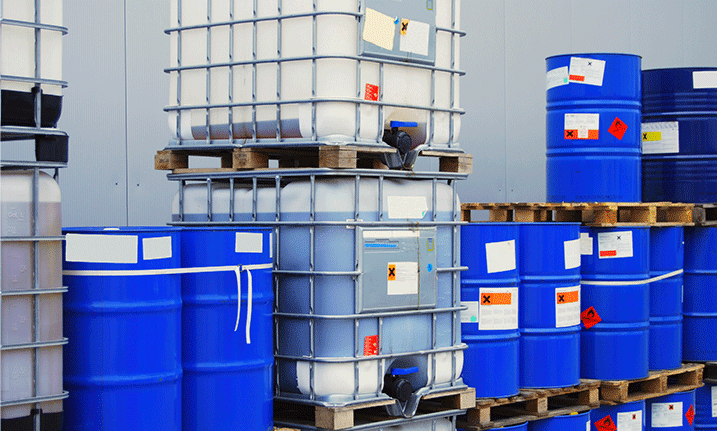

Plans to strengthen dangerous goods regulations in Victoria were recently announced by Worksafe outlining the changes made to the Dangerous Goods (Storage and Handling) Regulations 2012.
The amendments will require all duty holders to notify WorkSafe every two years about changes to prescribed quantities of stored dangerous goods that could significantly alter the risk profile of their premises. Prescribed changes can include a significant change in the quantity or type of dangerous goods, changed ownership or control of the dangerous goods. Previously, notification was required every five years.
The increased reporting will provide more relevant information to WorkSafe to help inform a risk-based approach to regulatory management of premises where significant quantities of dangerous goods are stored.
What are dangerous goods?
Dangerous goods are substances that are corrosive, flammable, combustible, explosive, oxidising, water-reactive, or have other hazardous properties. Dangerous goods can cause explosions or fires, large-scale damage, serious injury, or death.
Examples of common dangerous goods include,
- flammable liquids (petrol, kerosene, turpentine, flammable paints etc.)
- corrosives (hydrochloric acid)
- flammable gases (LP Gas)
- non-flammable non-toxic gases (CO2)
- asbestos
- explosives
If dangerous goods are stored or handled at your workplace here are four practical steps you can take to comply with the code of practice for storage and handling of dangerous goods.
1. Manage the risks
The first step is to identify all risks related to the dangerous goods stored or handled at your workplace. That includes any dangerous goods generated during a manufacturing process.
Manufacturers and suppliers must supply you with a safety data sheet (SDS) with dangerous goods. There must also be package markings and class or hazard class information. These will help you identify what is in a product, precautions for use, and safe storage and handling requirements.
If necessary, assess the risk to understand the nature of harm that could be caused by the dangerous goods stored or handled at your workplace. Risk Management systems such as Rapid Risk are designed to assist you in identifying, assessing, and implementing controls to minimise workplace risks.
2. Induction & training
To comply with the code of practice, all staff, and contractors involved with the storage and handling of dangerous goods must be provided with induction and training. The information that should be included in the training should cover key aspects such as;
- nature of the hazards and properties of the dangerous goods and the processes used for the identification and control of the risks associated with the person’s tasks
- purpose, use, and maintenance of the measures for the control of those risks
- systems of work and the conduct of persons at the premises to the extent this affects the safe storage and handling of dangerous goods
- operation of the emergency plan for the site and any procedures and equipment that may be required for use in the event of an emergency, and
- proper use and fitting of personal protective equipment (PPE)
Whilst keeping records of your induction and training is not mandatory, a system like Rapid Induct may help you streamline your site inductions and training processes and help you to demonstrate compliance with the regulations.
3. Managing site visitors
If customers or visitors are entering your workplace, sufficient measures, information, and safety instructions need to be in place to ensure their safety during the visit. Visitors should be properly informed about;
- the hazards they may be exposed to while on the site
- appropriate safety measures to be applied while visiting your site (e.g. wearing PPE)
- what actions to take if any emergency occurs
The need for a formal system such as Rapid Access to restrict access to the site and also deliver safety information to visitors will depend on several factors including;
- nature and severity of hazards on the site
- extent of the site and the degree of access provided, and
- degree of supervision for visitors
In some high-risk situations, it may be necessary to verify through assessment whether visitors have a satisfactory understanding of the safety information.
4. On-going safety audits and inspections
As part of your workplace’s safety management system, it’s important to ensure regular safety audits and inspections are scheduled and carried out to continually assess the risks, how effective the safety measures in place are, as well as to identify any gaps.
It is recommended that you aim to have;
- regular workplace inspections
- regular monitoring of safety practices and procedures by management
- regular audits to verify that specific elements of the safety management system are working as intended
- annual audits of the safety management system as a whole
Additionally, you should aim to have informal workplace inspections as often as your business can manage. How often you should conduct audits, inspections and reviews in your workplace will also depend on;
- the degree of risk associated with the activities carried out in the operation of your business
- management commitment to continuous improvement in health and safety performance
- whether there is a reason to believe that health and safety requirements are not being met
Automating your audit management process with a system like Rapid Auditor will allow you to reduce the complexity of the audit process and improve compliance across all areas of your business.
If you are interested in meeting WHS compliance or creating a risk management plan, reach out to the Rapid team today.
Our qualified consultants will walk you through a free demonstration of our workforce management software and show you how to customise and configure the system for the unique needs of your industry and employment sector.







